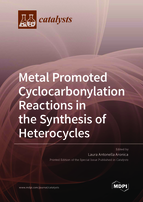Metal Promoted Cyclocarbonylation Reactions in the Synthesis of Heterocycles
A special issue of Catalysts (ISSN 2073-4344). This special issue belongs to the section "Catalysis in Organic and Polymer Chemistry".
Deadline for manuscript submissions: closed (31 October 2021) | Viewed by 25475
Special Issue Editor
Interests: carbonylative cross-coupling; catalyzed synthesis of oxygen and nitrogen heterocycles; silylcarbocyclization reactions; heterogeneous catalysis
Special Issue Information
Dear Colleagues,
Oxygen and nitrogen heterocycle systems are found in a vast number of natural substrates and biologically active molecules such as antimycotics, antibiotics, antioxidants, pigments, and fluorophores. Therefore, several procedures dedicated to the building of such heterocycles have been developed. Many of them are based on the cyclization of suitable substrates, multi-component reactions, and ring expansion processes.
In this field, metal-catalyzed cyclocarbonylative reactions represent atom-economical and efficient methods for the synthesis of several functionalized compounds. Indeed, when the cyclization reaction is performed under CO pressure or in the presence of its surrogates the potentiality of the process is enhanced since the formation of the ring takes place with the contemporary introduction of the carbonyl functional group.
This Special Issue will focus on metal-catalyzed cyclocarbonylation reactions applied to the synthesis of heterocyclic rings of different sizes, including diastereoselective and enantioselective approaches, homogeneous and heterogeneous metal catalysis, and the application of these reactions to the total synthesis of natural products.
Submissions are very much welcome in the form of original research papers or short reviews that reflect the state-of-the-art of this research area.
Dr. Laura Antonella Aronica
Guest Editor
Manuscript Submission Information
Manuscripts should be submitted online at www.mdpi.com by registering and logging in to this website. Once you are registered, click here to go to the submission form. Manuscripts can be submitted until the deadline. All submissions that pass pre-check are peer-reviewed. Accepted papers will be published continuously in the journal (as soon as accepted) and will be listed together on the special issue website. Research articles, review articles as well as short communications are invited. For planned papers, a title and short abstract (about 100 words) can be sent to the Editorial Office for announcement on this website.
Submitted manuscripts should not have been published previously, nor be under consideration for publication elsewhere (except conference proceedings papers). All manuscripts are thoroughly refereed through a single-blind peer-review process. A guide for authors and other relevant information for submission of manuscripts is available on the Instructions for Authors page. Catalysts is an international peer-reviewed open access monthly journal published by MDPI.
Please visit the Instructions for Authors page before submitting a manuscript. The Article Processing Charge (APC) for publication in this open access journal is 2700 CHF (Swiss Francs). Submitted papers should be well formatted and use good English. Authors may use MDPI's English editing service prior to publication or during author revisions.
Keywords
- Carbonylation
- Coupling reactions
- Cyclization
- N-heterocycles
- O-heterocycles
- Heterogeneous or homogeneous catalysts






